
The Legion of Super-Heroes is a superhero team appearing in American comic books published by DC Comics. Created by writer Otto Binder and artist Al Plastino, the Legion is a group of superpowered beings living in the 30th and 31st centuries of the DC Comics Universe, and first appeared in Adventure Comics #247.
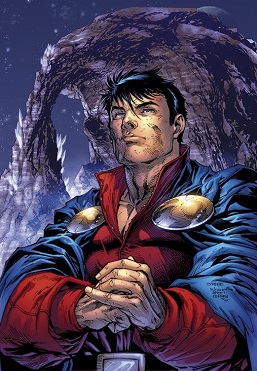
Lar Gand, known mainly as Mon-El, is a superhero appearing in American comic books published by DC Comics, commonly in association with the Legion of Super-Heroes, Superboy, and Superman. The character has been reinterpreted over the years, but in all versions serves as a hero with abilities similar to those of Superman, sometimes serving as a substitute for him.

Brainiac 5 is a superhero appearing in comics published by DC Comics. He is from the planet Colu and is a long-standing member of the Legion of Super-Heroes in the 30th and 31st centuries.

Ayla Ranzz, also known as Lightning Lass, Light Lass, Gossamer, and Spark, is a character appearing in media published by DC Comics. She is a member of the Legion of Super-Heroes in the 30th and 31st centuries, as well as the sister of Lightning Lad and Lightning Lord.
Invisible Kid is the name of two superheroes in the DC Comics universe, both of whom are members of the Legion of Super-Heroes in the 30th and 31st centuries.
The Legion of Super-Villains is a team of supervillains who appear in comic books published by DC Comics, primarily as enemies of the Legion of Super-Heroes. They first appeared in Superman #147.

Karate Kid is a superhero appearing in the DC Comics universe, primarily as a member of the Legion of Super-Heroes. He is a master of every form of martial arts to have been developed by the 31st century. The extent of his skill is so great that he can severely damage various types of hard material with a single blow and was briefly able to hold his own against Superboy through what he called "Super Karate".
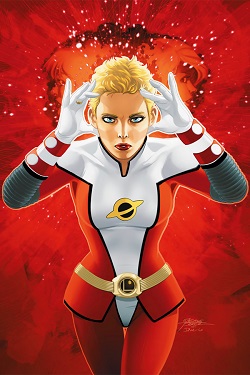
Saturn Girl is a superheroine appearing in comics published by DC Comics. A talented telepath from the 30th century, Saturn Girl is a founding member of the Legion of Super-Heroes. Imra's "Saturn Girl" title refers to her homeworld of Titan, Saturn's largest moon. There have been three versions of Imra since her original debut, separated by the events of the limited series Zero Hour: Crisis in Time! and Infinite Crisis.

Matter-Eater Lad is a superhero appearing in media published by DC Comics, primarily as a member of the Legion of Super-Heroes in the 30th and 31st centuries. He first appeared in Adventure Comics #303, and possesses the power to eat matter in all forms, as do all natives of his home planet, Bismoll.
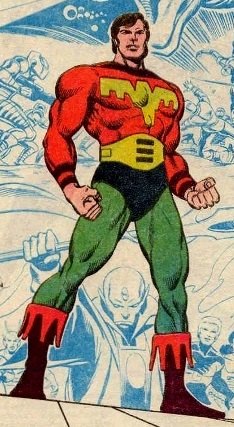
Ultra Boy is a superhero appearing in DC Comics, primarily as a member of the Legion of Super-Heroes in the 30th and 31st centuries. He gained his powers after being eaten by a whale-like beast in space and being exposed to large amounts of radiation while inside. His real name is derived from the Biblical figure Jonah, who also survived being swallowed by a "large fish".
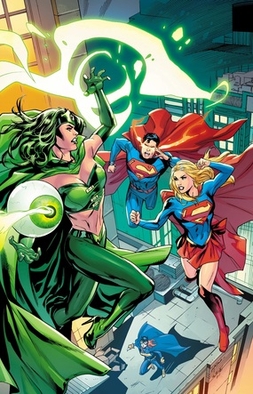
The Emerald Empress is the name of several, fictional super-villains appearing American comic books published by DC Comics. The characters associated with the name are often portrayed as a prominent adversary of the Legion of Super-Heroes. The first incarnation of the character appeared in Adventure Comics #352.
Persuader is the name for three unrelated supervillains appearing in comic books published by DC Comics.

Legion of Super Heroes is an American animated television series produced by Warner Bros. Animation, adapted from the DC Comics series of the same name. It debuted on September 23, 2006, and centers on a young Superman's adventures in the 31st century, fighting alongside the eponymous group of superheroes. The show was produced by one of its main character designers James Tucker, a co-producer of the Justice League Unlimited series, for the Kids' WB line-up on The CW network.
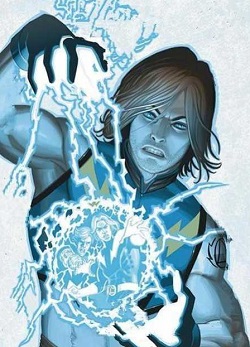
Garth Ranzz, also known as Live Wire and Lightning Lad, is a superhero appearing in media published by DC Comics, usually those featuring the Legion of Superheroes, a 30th and 31st century group of which he is a founding member. He has the superhuman ability to generate electricity, usually in the form of lightning bolts.

Superboy's Legion is a two-issue comic book mini-series, published by DC Comics cover dated February and March 2001, under the Elseworlds imprint. Written by Mark Farmer, with art by Farmer and Alan Davis. The comic series is a tale about the baby Kal-El, the last survivor of the doomed planet Krypton, arrives on Earth in the 30th century and is found by billionaire R.J. Brande. As Kal grows up, he decides to find other super-powered teens like himself and form a Legion of Super-Heroes. The story uses elements from the Silver Age Comics, most notably the original Legion of Super-Heroes series.

"The Great Darkness Saga" is a five-issue American comic book story arc featuring the Legion of Super-Heroes. It was written by Paul Levitz, with art by Keith Giffen and Larry Mahlstedt. Published by DC Comics in 1982, the arc first appears in Legion of Super-Heroes vol. 2, #290–294. It is notable for featuring appearances by virtually every living past and present Legionnaire as of 1982, as well as most of the team's 30th-century allies, including the Legion of Substitute Heroes, the Wanderers, the Heroes of Lallor, and the 20th-century Kryptonian refugee Dev-Em. The heroes battle an immensely powerful being shrouded in darkness, ultimately revealed to be the ancient ruler of Apokolips, Darkseid.
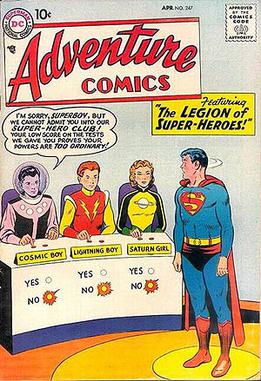
The 1958 version of the Legion of Super-Heroes is a fictional superhero team in the 31st century of the DC Comics Universe. The team is the first incarnation of the Legion of Super-Heroes, and was followed by the 1994 and 2004 rebooted versions. It first appeared in Adventure Comics #247 and was created by Otto Binder and Al Plastino.
"The Death of Ferro Lad" is an American comic book story arc that was published as "The Fatal Five" by DC Comics, and was presented in Adventure Comics #352-353. It was written by Jim Shooter, with art by Curt Swan and George Klein. The story arc includes the first appearance of the villainous Fatal Five. It is also notable for featuring the first "permanent" death of a member of the Legion of Super-Heroes.

Ol-Vir is a supervillain appearing in media published by DC Comics. He first appeared in Legion of Super-Heroes #294, and is often depicted as a member of the Legion of Super-Villains.

Justice League vs. the Fatal Five is a 2019 American animated superhero film produced by Warner Bros. Animation and DC Entertainment. Featuring the DC Comics team Justice League created by Gardner Fox, the film is the 36th of the DC Universe Animated Original Movies. The film features the voices of Elyes Gabel and Diane Guerrero alongside Kevin Conroy, Susan Eisenberg, and George Newbern reprising their roles as Batman, Wonder Woman, and Superman, from various DC productions.
















